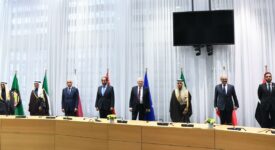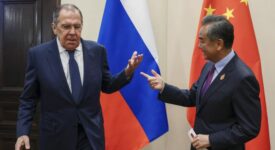The US and Iran have declared that they are willing to return to their commitments under the JCPOA, the 2015 nuclear deal. However, discussions are at a standstill. The EU has a short window of opportunity to spearhead shuttle diplomacy between Tehran and Washington. By doing so, the EU would demonstrate that it is a reliable geopolitical partner, shaping regional developments rather than waiting to follow Washington’s lead. Passivity is not an option as the clock is ticking. Not only is Tehran stepping up its uranium enrichment programme, it has also announced that it will limit UN inspectors’ access to its nuclear activities. Furthermore, with Iran’s June presidential election likely to bring a more hard-line government to power, the EU must intensify its efforts urgently to salvage the deal.
MAXIMUM PRESSURE, ZERO GAIN — The JCPOA – agreed between China, Germany, France, Russia, the UK, the US (P5+1) and Iran – placed curbs on Iran’s nuclear programme in return for sanctions relief. In 2018, the Trump administration withdrew from the deal and launched a “maximum pressure” campaign against Tehran, including crushing economic sanctions. Hundreds of new, primary and secondary organisations and sectors, including EU businesses, were targeted. However, the reimposition of sanctions did not bring Iran back to the negotiating table. Nor did it curtail the country’s influence in its neighbourhood. Rather, Iran responded with maximum resistance by, for example, ramping up its naval military operations in the Persian Gulf. Regional tensions increased, with two events bringing the US and Iran to the brink of direct military confrontation: Iran shooting down a US drone over the Strait of Hormuz in June 2019 and the US’ assassination of General Qasem Soleimani. A war would be catastrophic for the entire region and beyond. While Iran did not leave the JCPOA following Washington’s withdrawal, it did start to reduce compliance some 12 months later by increasing its level of uranium enrichment.
BIDEN GETTING BACK ON TRACK — US President Joe Biden is under pressure not to re-enter the JCPOA. Besides domestic opposition, he also faces pressure from allies in the region, particularly Israel and Saudi Arabia. Two factors drive Biden’s commitment to reengage with Iran, nevertheless. First, he has no illusion about the nature of the Iranian regime or its threat to US security interests. But he has always advocated direct dialogue with Tehran, and the JCPOA is a crucial framework for this. Second, he believes that it is essential to prevent Iran from acquiring nuclear weapon capability or anything similar. Maintaining maximum pressure to inflict more pain will not bring Tehran back to the negotiating table or halt its nuclear ambitions. In fact, restoring the JCPOA can lay the foundations for a follow-on agreement that addresses other issues and concerns, such as regional security, terrorism and Iran’s ballistic missile programme.
THE ROAD AHEAD — The road to returning to the JCPOA is not straightforward. Both the US and Iran are reluctant to take the first step. And yet, Iran would have much to gain. US sanctions have negatively impacted its economy, which was damaged further by the COVID-19 pandemic. But since it was Washington that walked away from the deal – leaving Iran with zero trust in the US – Tehran insists that the sanctions be removed first. This is a hard pill for Biden to swallow: Iran breached its obligations under the JCPOA and continues to do so. In January, uranium enrichment at Fordow nuclear plant reached 20%, the highest level reached before implementing the JCPOA (which set the limit at 3.67%). Furthermore, according to the International Atomic Energy Agency (IAEA), Iran has now produced uranium metal, a material that can be used to make nuclear weapons. Washington’s small steps aimed at confidence building, such as Biden’s recent decision to ease his predecessor’s tough restrictions on Iranian UN diplomats’ intra-US travel, will not suffice to reverse this trend.
CAN THE EU BREAK THE STANDOFF? — Biden has appointed Robert Malley, former head of the International Crisis Group and lead negotiator on the JCPOA, as his special envoy for Iran. However, he is yet to be authorised to talk directly with Iran, as the Biden administration’s relevant policies are still being crafted. Despite the US’ withdrawal and Iran’s breaches, Europe kept talking to Iran and chairs the JCPOA’s Joint Commission. The E3 (UK, France, Germany) and the EU worked hard to maintain nuclear diplomacy with Iran. This makes Josep Borrell, EU High Representative for Foreign Affairs, Tehran’s natural interlocutor. Both Tehran and Washington have also greenlighted Borrell. Iran’s foreign minister, Mohammad Javad Zarif, called on him to coordinate a synchronised return of both parties to the deal. US Secretary of State Tony Blinken has said that if the EU sketched out a possible diplomatic path to restore the JCPOA, Washington would accept an invitation from Borrell to a meeting of the P5+1 and Iran.
STEP BY STEP, COMPLIANCE BY COMPLIANCE — The EU’s shuttle diplomacy should be assertive and swift. Although there is a long way to go before all the challenges related to Iran are addressed, returning to compliance with the JCPOA is the key starting point. And time is running out. If hardliners come to power in Iran in June, it will further complicate a return to the deal. The first step is to reach a ‘compliance for compliance’ agreement. This means synchronised compliance, with Washington scrapping all the JCPOA-related sanctions and Tehran returning to compliance. Both parties would simultaneously announce a recommitment to obligations under the deal and a rollback of actions. Biden could already issue an executive order to revoke Trump’s 2018 withdrawal and ask the Treasury and State departments to review the sanctions. This is likely to bring about a similar political directive from Tehran. Restoring the JCPOA would be a crucial confidence-building step. Once done, new negotiations on possible changes to the deal can commence. Addressing the deal’s weaknesses so that it can withstand future political upheavals would be key.
ENTER THE EU — The E3 has carried out shuttle diplomacy in the past. Now, the EU/E3 diplomatic format, led by Borrell, must not pussyfoot around. They must quickly propose a roadmap with timelines for the US and Iran to return to full JCPOA compliance. The IAEA should also partake in this process, along with Russia and China. The EU must also underline that the JCPOA’s framework remains unchanged. Recent proposal by French President Emmanuel Macron that Saudi Arabia and Israel should be part of the negotiations are unhelpful and unacceptable for Iran, which insists that the negotiation format must remain the same. Macron should promote EU unity and support Borrell’s leadership, allowing the Union to have a single strategy. Borrell can also initiate quiet diplomacy to address other important issues, such as Iran’s ballistic missile capacity, regional security and sanctions relief. The EU’s moment to grasp an important role in this troubled region’s security and political dynamics is now. Brokering a deal and fostering regional multilateral cooperation is where the EU can add value. The EU has supported the nuclear deal consistently since 2015. Now, the Union must step out of its preferred passenger’s seat and into the driver’s seat.
‚Stepping into the Driver’s Seat: The EU Should Double Down on US–Iran Diplomacy‘ – Commentary by Amanda Paul and Mihai Sebastian Chihaia – European Policy Centre / EPC.







